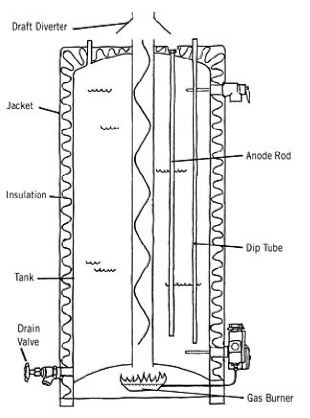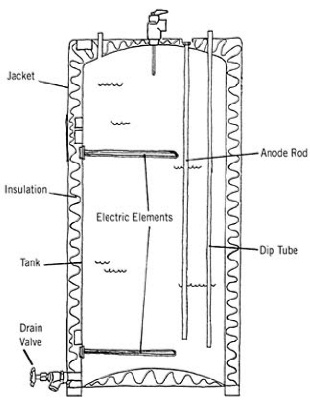
Although heating water falls under the H in HVAC, you are not likely to find water heaters there. By the way, if you’re looking for information on hot water heaters, I have the e-mail addresses of about 100 grizzled veterans who would love to bestow upon you the difference between hot water heaters and water heaters. Although nearly every dwelling in America has a water heater, they tend to be overlooked in our profession — from textbooks right to the technician who walks past the water heater to tune up the furnace.
By obtaining a good working knowledge of water heaters, you are preparing yourself to fulfill a customer need and at the same time create opportunities for your company.
Today we will examine the basics of gas and electric water heaters. The following are components common to both gas and electric water heaters.

Components
Drain valve— Located at the bottom of the tank, the drain valve provides a way to drain and flush the tank. Drain valves are made of plastic or brass.Dip tubes — Cold water enters the tank and travels down the dip tube to the bottom to be heated. As the water heats up, it becomes less dense and rises towards the top of the tank for discharge. Most dip tubes are plastic, and some are curved near the bottom. Curved tubes swirl the water, preventing a buildup of sediment on the bottom.
Anodes — Water heaters consist of a steel tank lined by glass. Over time, the glass dissolves or wears away and exposes the steel. To prevent the steel from rusting, an anode is inserted into the top of the tank. Made from an alloy of aluminum, zinc, or magnesium surrounding a steel wire, the alloy dissolves by way of an electrochemical reaction. As long as alloy remains on the rod, the steel tank will not rust.
Temperature and pressure relief valve — A safety valve that senses both temperature and pressure. If temperature exceeds 210 degrees F, the valve opens and releases hot water, allowing cold water to enter and prevent overheating. If pressure exceeds 150 pounds per square inch, the valve opens and relieves excess pressure. This valve is sometimes referred to as a pop-off valve.
Controls
Gas water heaters— This control is a combination thermostat and gas valve. A temperature probe is immersed into the water at the bottom of the tank. The thermostat regulates the valve in order to maintain the desired temperature of the water.Electric water heaters — Heating elements are inserted at the high and low points of the tank (some use only one element). A separate thermostat located on the outside of the tank controls each element. High limit controls keep water temperature from exceeding a predetermined limit. Elements may be each wired into a separate high limit control or wired into one limit.
Vent System
Gas water heaters require venting. Atmospheric systems use a draft hood and are vented by means of flue pipe to chimneys. Power vented systems vent flue gases to the outside by means of an electrical power venter using stainless steel or plastic tubing as a conduit.Thermal Expansion Tank
Although the thermal expansion tank is not attached to the water heater, it plays an important role in the safe operation of select systems. When water is heated, it expands. If there is a backflow preventer, a pressure reducing valve, a check valve, or any combination thereof in the cold water feed to the water heater, the heated water will expand, and, providing all faucets are closed, cause an overpressurization of the system. A leaking pop-off valve is a symptom of this problem. The solution is to install a thermal expansion tank in line with the cold water supply. The heated water then has a place to expand.We have touched on some very basic points about water heaters here today. For additional information on maintenance, troubleshooting, application, and general knowledge, visit www.waterheaterrescue.com. Another excellent resource is The Water Heater Book, by Larry and Suzanne Weingarten. This information-packed book can be purchased at www.heatinghelp.com.
Rothacker is a member of the National Comfort Institute’s Advisory Board and a National Comfort Team Founding Member. For questions or comments on the Tech Basics, contact Rothacker at ewizaard@hotmail.com.
Publication date: 03/31/2003




